Pytorch Implementation of Variational AutoEncoders (VAEs)
22 May 2022< 목차 >
- AutoEncoder (AE)
- Variational AutoEncoder (VAE)
- Vector Quantized Variational AutoEncoder (VQ-VAE)
- References
이번 post 에서는 Variational AutoEncoder (VAE) model들을 직접 학습해보려고 한다.
Alexander Van de Kleut의 post를 base로 삼았다.
VAE 에 관한 이론적인 내용은 저의 블로그 내 다른 post 를 참고하시면 좋을 것 같다.
AutoEncoder (AE)
VAE를 구현하기 전에 유사한 구조체인 Auto Encoder (AE)를 먼저 학습해보려고 한다.
AE 는 다음과 같이 생겼는데,
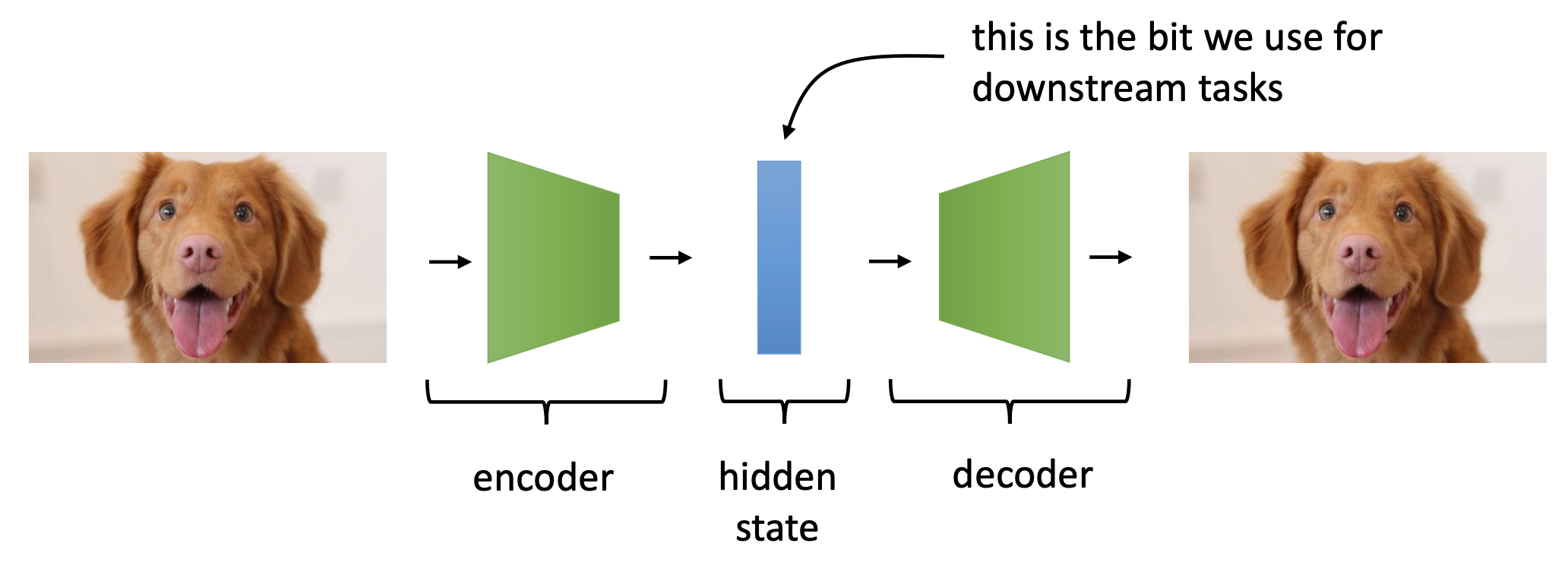 Fig. Encoder 와 Decoder 로 이루어진 아주 간단한 AutoEncoder 모델
Fig. Encoder 와 Decoder 로 이루어진 아주 간단한 AutoEncoder 모델
다들 아시다시피 input 정보를 압축하는 Encoder와 이를 복원하는 Decoder가 있으며, 목적은 input 을 잘 나타내는 feature (representation) 을 encoder가 학습하는 것이다.
Encoder와 Decoder를 아래처럼 간단하게 구성해준다.
class Encoder(nn.Module):
def __init__(self, image_size, num_channel, latent_dims):
super(Encoder, self).__init__()
self.linear1 = nn.Linear(image_size**2 * num_channel, 512)
self.linear2 = nn.Linear(512, latent_dims)
def forward(self, x):
x = torch.flatten(x, start_dim=1)
x = F.relu(self.linear1(x))
return self.linear2(x)
class Decoder(nn.Module):
def __init__(self, image_size, num_channel, latent_dims):
super(Decoder, self).__init__()
self.linear1 = nn.Linear(latent_dims, 512)
self.linear2 = nn.Linear(512, image_size**2 * num_channel)
self.image_size = image_size
self.num_channel = num_channel
def forward(self, z):
z = F.relu(self.linear1(z))
z = torch.sigmoid(self.linear2(z))
return z.reshape((-1, self.num_channel, self.image_size, self.image_size))
왜 Decoder의 최종 출력값이 0~1로 mapping되느냐? (sigmoid를 왜 쓰느냐?), 그 이유는 우리가 사용할 데이터셋이 MNIST 인데 이 데이터는 흑백 이미지 데이터로 각 픽셀값이 0~1 로 이루어져 있기 때문이다. 이제 이 인코더가 뱉은걸 디코더가 받도록 구성해주면 끝이다.
class Autoencoder(nn.Module):
def __init__(self, image_size, num_channel, latent_dims):
super(Autoencoder, self).__init__()
self.encoder = Encoder(image_size, num_channel, latent_dims)
self.decoder = Decoder(image_size, num_channel, latent_dims)
def forward(self, x):
z = self.encoder(x)
return self.decoder(z)
간단하게 argparser로 몇 가지 인자를 정의해주고
parser = argparse.ArgumentParser()
parser.add_argument('--dataset_dir_path', type=str, default='./data')
parser.add_argument('--batch_size', type=int, default=256)
parser.add_argument('--num_epoch', type=int, default=25)
parser.add_argument('--lr', type=float, default=0.001)
parser.add_argument('--lr_step', type=float, default=1.0)
parser.add_argument('--latent_dims', type=int, default=2)
parser.add_argument('--log_interval', type=int, default=50)
parser.add_argument('--plot', action='store_true')
args = parser.parse_args()
아래처럼 torchvision library의 데이터셋을 사용해서 data loader를 만든다.
dataset = torchvision.datasets.MNIST(args.dataset_dir_path,
train=True,
transform=torchvision.transforms.ToTensor(),
download=True)
dataset_test = torchvision.datasets.MNIST(args.dataset_dir_path,
train=False,
transform=torchvision.transforms.ToTensor(),
download=True)
image_size = 28
num_channel = 1
data_loader = torch.utils.data.DataLoader(dataset, batch_size=args.batch_size, shuffle=True,num_workers=4)
data_loader_test = torch.utils.data.DataLoader(dataset_test, batch_size=args.batch_size, shuffle=False,num_workers=4)
학습을 하려면 당연히 아까 만든 Autoencoder class를 model로 선언해주고 optimizer 등을 정의해줘야 한다.
model = Autoencoder(image_size, num_channel, args.latent_dims).to(device)
optimizer = torch.optim.AdamW(model.parameters(), lr=args.lr)
lr_scheduler = torch.optim.lr_scheduler.StepLR(optimizer, step_size=int(args.num_epoch*args.lr_step), gamma=0.333)
이제 data loader, model 그리고 optimizer 를 사용해서 training loop 를 돌리면 된다.
for epoch in range(args.num_epoch):
train_num_batches = len(data_loader)
test_num_batches = len(data_loader_test)
model.train()
lr = lr_scheduler.get_last_lr()[0]
for i, (x,y) in enumerate(data_loader):
x = x.to(device)
pred = model(x)
loss = F.mse_loss(pred, x, reduction='sum')
optimizer.zero_grad()
loss.backward()
optimizer.step()
if i % args.log_interval == 0 and i > 0:
print(f'| epoch {epoch:3d} | '
f'{i:5d}/{train_num_batches:5d} batches | '
f'lr {lr:02.4f} | '
f'loss {loss:5.3f}')
model.eval()
val_loss = 0.0
for i, (x,y) in enumerate(data_loader_test):
x = x.to(device)
with torch.no_grad():
pred = model(x)
loss = F.mse_loss(pred, x, reduction='sum')
val_loss += loss.item()
print(f'| epoch {epoch:3d} | lr {lr:02.4f} | total validation loss {val_loss/test_num_batches:5.3f}')
lr_scheduler.step()
아주 간단하죠.
pred = model(x)
loss = F.mse_loss(pred, x, reduction='sum')
특히 단순하게 이미지 픽셀을 원본과 비교하면서 복원하는게 전부이기 때문에 loss는 mse loss를 쓴 걸 알 수 있다. (하지만 이 post에서도 설명했듯 흑백 이미지는 픽셀이 0이냐 1이냐로 나눌 수도 있기 때문에 Binary Cross Entropy (BCE)를 사용해서 학습해도 된다)
마지막으로 학습 결과로 Encoder가 어떻게 mnist 이미지를 학습했는지 보도록 하겠다.
if args.plot:
save_dir_path = os.path.join(os.getcwd(),'assets')
if not os.path.isdir(save_dir_path) : os.mkdir(save_dir_path)
plot_latent(model, data_loader_test, save_dir_path)
plot_reconstructed(model, image_size, num_channel, save_dir_path, r0=(-10, 10), r1=(-10, 10), n=15)
위에서 사용한 plot 함수는 아래처럼 정의된다.
def plot_latent(model, data_loader, save_dir_path):
plt.clf()
for i, (x, y) in enumerate(data_loader):
z = model.encoder(x.to(device))
z = z.to('cpu').detach().numpy()
plt.scatter(z[:, 0], z[:, 1], c=y, cmap='tab10')
plt.colorbar()
file_path = os.path.join(save_dir_path,'latent_space.png')
if os.path.exists(file_path) : os.remove(file_path)
plt.savefig(file_path)
def plot_reconstructed(model, image_size, num_channel, save_dir_path, r0=(-3, 3), r1=(-3, 3), n=15):
plt.clf()
w = image_size
img = np.zeros((n*w, n*w, num_channel))
for i, y in enumerate(np.linspace(*r1, n)):
for j, x in enumerate(np.linspace(*r0, n)):
z = torch.Tensor([[x, y]]).to(device)
x_hat = model.decoder(z)
x_hat = x_hat.reshape(num_channel, image_size, image_size)
recon_img = x_hat.permute(1, 2, 0).to('cpu').detach().numpy()
img[(n-1-i)*w:(n-1-i+1)*w, j*w:(j+1)*w, :] = recon_img
plt.imshow(img, extent=[*r0, *r1])
file_path = os.path.join(save_dir_path,'reconstruct_images.png')
if os.path.exists(file_path) : os.remove(file_path)
plt.savefig(file_path)
저장된 plot 이미지를 보면 아래와 같은데,
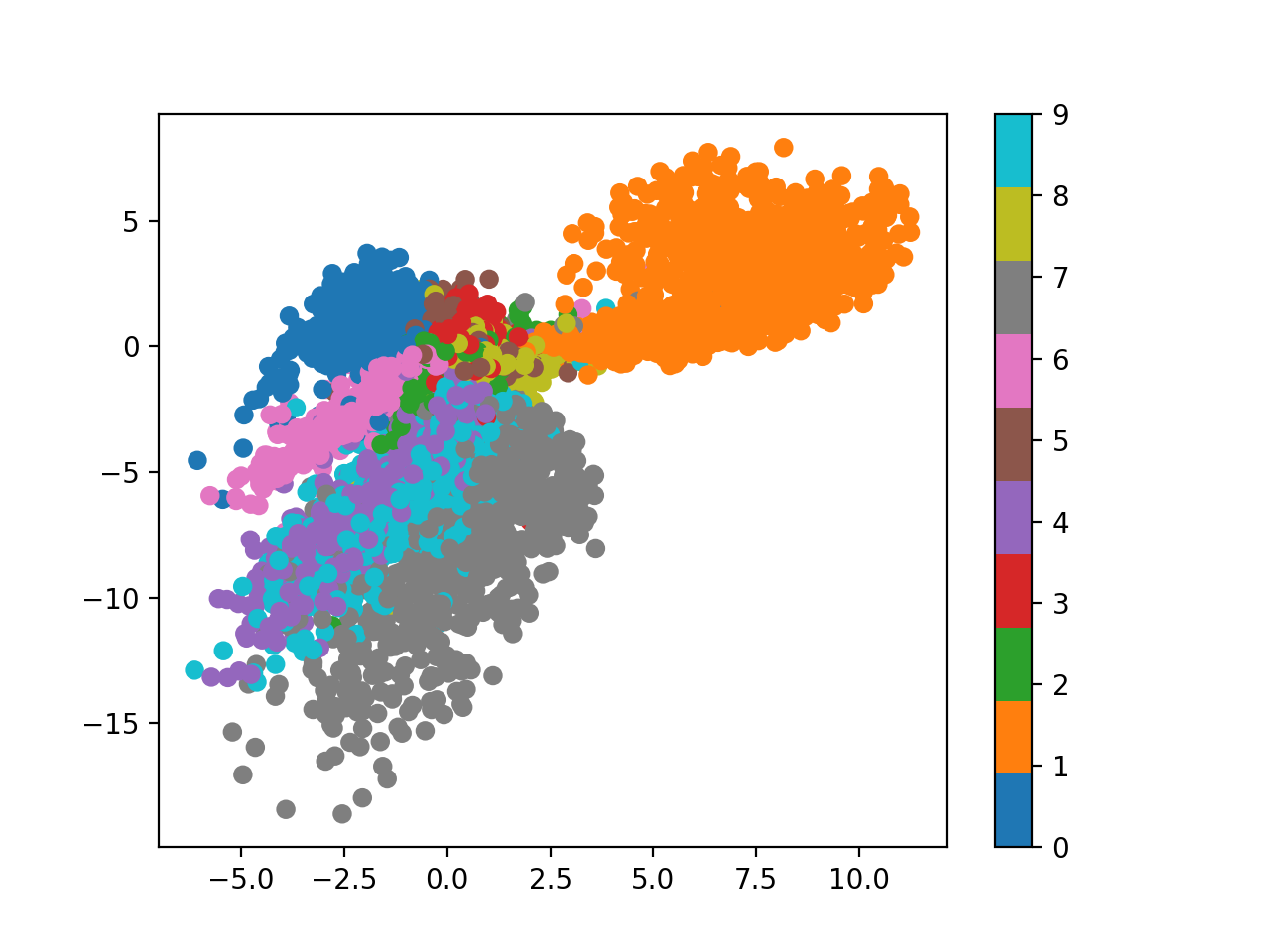 Fig. 2-dim Latent Space from AutoEncoder
Fig. 2-dim Latent Space from AutoEncoder
첫 번째 이미지는 우리가 AutoEncoder의 hidden dimension, 즉 latent dimension 을 2로 정했기 때문에 이를 2차원 좌표상에 나타낸 것이다.
잘 보시면 어느정도 같은 숫자를 나타내는 데이터들이 뭉치는걸 볼 수 있지만 딱히 맘에 들지는 않는다.
여러 이유가 있을 수 있다.
- model 이 너무 간단하다.
- lr, num_epoch 등 하이퍼 파라메터가 적절하지 못했다.
그 다음으로는 우리가 2차원 좌표상에 Latent Vector들이 어떻게 mapping됐는지 이해했으니 거기서부터 이미지를 복원해보고 이를 plot해본 것인데,
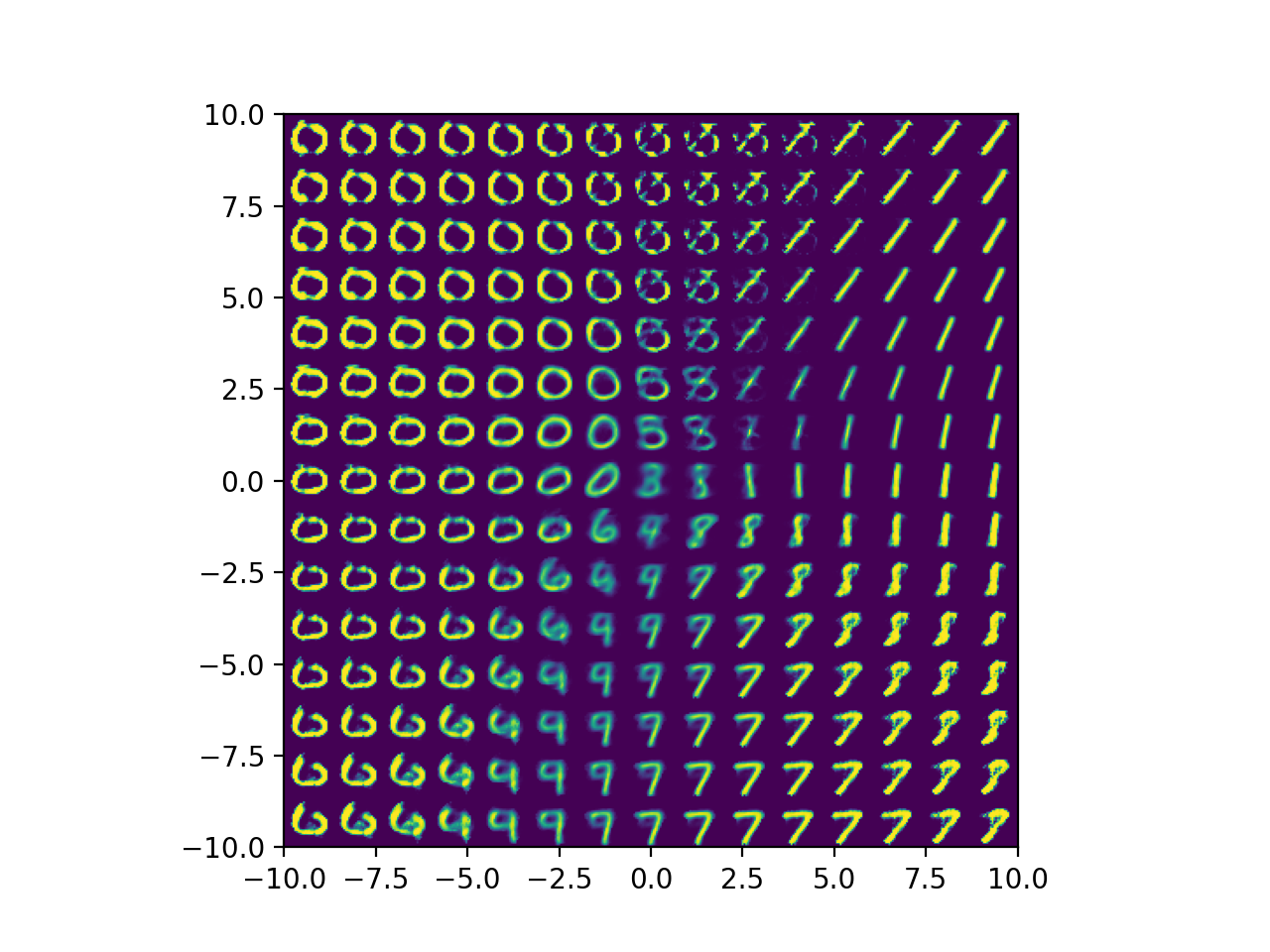 Fig. Decoded Images from 2-dim Latent Space Points
Fig. Decoded Images from 2-dim Latent Space Points
1사분면쪽에서 복원한 이미지들은 대부분 1인걸로 봐서 디코더도 적당히 학습된걸 알 수 있다.
Variational AutoEncoder (VAE)
이제 VAE를 구현해보자. AE와 유사한 구조를 가지고 있지만 몇 가지 다른점이 있다.
- Encoder는 Latent Dim 차원의 Vector를 뱉는게 아니라, Latent Dim 차원의
가우시안 분포(다른거여도 되긴 하지만 보통 normal dist) 를 예측한다. 즉 가우시안 분포의 mean 값을 예측함. ELBO Objective를 썼다. (MSE Loss +KL Divergence Loss)- 미분 불가능한 샘플링 연산을 처리하기 위해
Reparameterization Trick을 썼다.
 Fig. VAE의 Encoder는 Fixed Vector가 아닌 어떠한 분포를 예측한다.
Fig. VAE의 Encoder는 Fixed Vector가 아닌 어떠한 분포를 예측한다.
VAE는 AE랑 구조 자체는 다른게 크게 없으니 구현체도 비슷하다.
class VariationalAutoencoder(nn.Module):
def __init__(self, image_size, num_channel, latent_dims):
super(VariationalAutoencoder, self).__init__()
self.encoder = Encoder(image_size, num_channel, latent_dims)
self.decoder = Decoder(image_size, num_channel, latent_dims)
def forward(self, x):
z = self.encoder(x)
return self.decoder(z)
Decoder도 뭐 latent vector z를 받아서 원래 이미지사이즈의 Tensor를 뱉는거니 크게 다른건 없는데,
class Decoder(nn.Module):
def __init__(self, image_size, num_channel, latent_dims):
super(Decoder, self).__init__()
self.linear1 = nn.Linear(latent_dims, 512)
self.linear2 = nn.Linear(512, image_size**2 * num_channel)
self.image_size = image_size
self.num_channel = num_channel
def forward(self, z):
z = F.relu(self.linear1(z))
z = torch.sigmoid(self.linear2(z))
return z.reshape((-1, self.num_channel, self.image_size, self.image_size))
문제는 Encoder이다.
class Encoder(nn.Module):
def __init__(self, image_size, num_channel, latent_dims):
super(Encoder, self).__init__()
self.linear1 = nn.Linear(image_size**2 * num_channel, 512)
self.linear_mean = nn.Linear(512, latent_dims) # for mean
self.linear_variance = nn.Linear(512, latent_dims) # for variance
self.N = torch.distributions.Normal(0, 1) # zero mean, unit variance gaussian dist
if device == 'cuda':
self.N.loc = self.N.loc.cuda() # hack to get sampling on the GPU
self.N.scale = self.N.scale.cuda()
self.kld = 0
def forward(self, x):
x = torch.flatten(x, start_dim=1)
x = F.relu(self.linear1(x))
mu = self.linear_mean(x) # mean
sigma = torch.exp(self.linear_variance(x)) # variance
z = mu + sigma * self.N.sample(mu.shape) # sampled with reparm trick
self.kld = (sigma**2 + mu**2 - torch.log(sigma) - 1/2).sum() # closed-form kl divergence solution
return z
이전 AE Encoder와 다른게 좀 있는데요, 바로 input을 hidden vector로 mapping하는 linear1 layer 뒤에 mean 과 variance 를 예측하는 linear layer가 각각 2개나 있다는 것이다. 즉 아래의 그림처럼 하기 위해서 각각을 예측하는 레이어가 두 개 있는 것이다.

여기에서 아래 부분이 중요한데,
mu = self.linear_mean(x) # mean
sigma = torch.exp(self.linear_variance(x)) # variance
z = mu + sigma * self.N.sample(mu.shape) # sampled with reparm trick
VAE에 대해서 다시 생각해보자.
- VAE
- What we want : \(p(x) = \int p(y \vert z) p(z) dz\)
- Encoder : \(q_{\phi}(z \vert x_i)\)
- Decoder : \(p_{\theta}(x_i \vert z)\)
ELBO: \(L(p_{\theta}(x_i \vert z), q_{\phi}(z \vert x_i)) = \mathbb{E}_{z \sim q_{\phi}(z \vert x_i)} [log p(x_i \vert z) + log p(z)] + H(q_{\phi}(z \vert x_i))\)
VAE는 ELBO 수식에 보면 이미지를 encoder에 태우면 어떤 분포 (보통 가우시안 분포)가 나오는데 여기에 기대값이 취해져 있다.
즉 원래같았으면 그 분포에서 뽑을 수 있는 z vector 는 다 뽑아서 계산을 해야 하는데 이건 불가능하므로 Sampling을 몇 번 하는걸로 대체하는 것이다.
즉 위의 코드에서 보면 가우시안 분포의 mean, variance값을 출력하는 각각의 레이어를 통과한건 알겠는데 여기에서 sigma에 어떤 self.N이라는 zero-mean unit variance 의 가우시안분포에서 뽑은 어떤 값을 곱해주는걸 알 수 있는데,
이게 바로 sampling효과를 내지만 미분을 가능하게 해주는 Reparameterization Trick이다.
- VAE
- ELBO : \(L(p_{\theta}(x_i \vert z), q_{\phi}(z \vert x_i)) = \mathbb{E}_{z \sim q_{\phi}(z \vert x_i)} [log p(x_i \vert z) + log p(z)] + H(q_{\phi}(z \vert x_i))\)
- Final Objective : \(\hat{\theta},\hat{\phi} = arg max_{\theta,\phi} ( \sum_{i=1}^{N} [ log p_{\theta} (x_i \vert \mu_{\phi} (x_i) + \epsilon \sigma_{\phi} (x_i) ) - D_{KL} ( q_{\phi} (z \vert x_i ) \parallel p(z) ) ] )\)
위의 수식에서 \(\epsilon\) 이 variance \(\sigma\)와 곱해져서 더해지는 부분이 바로 이 부분이다.
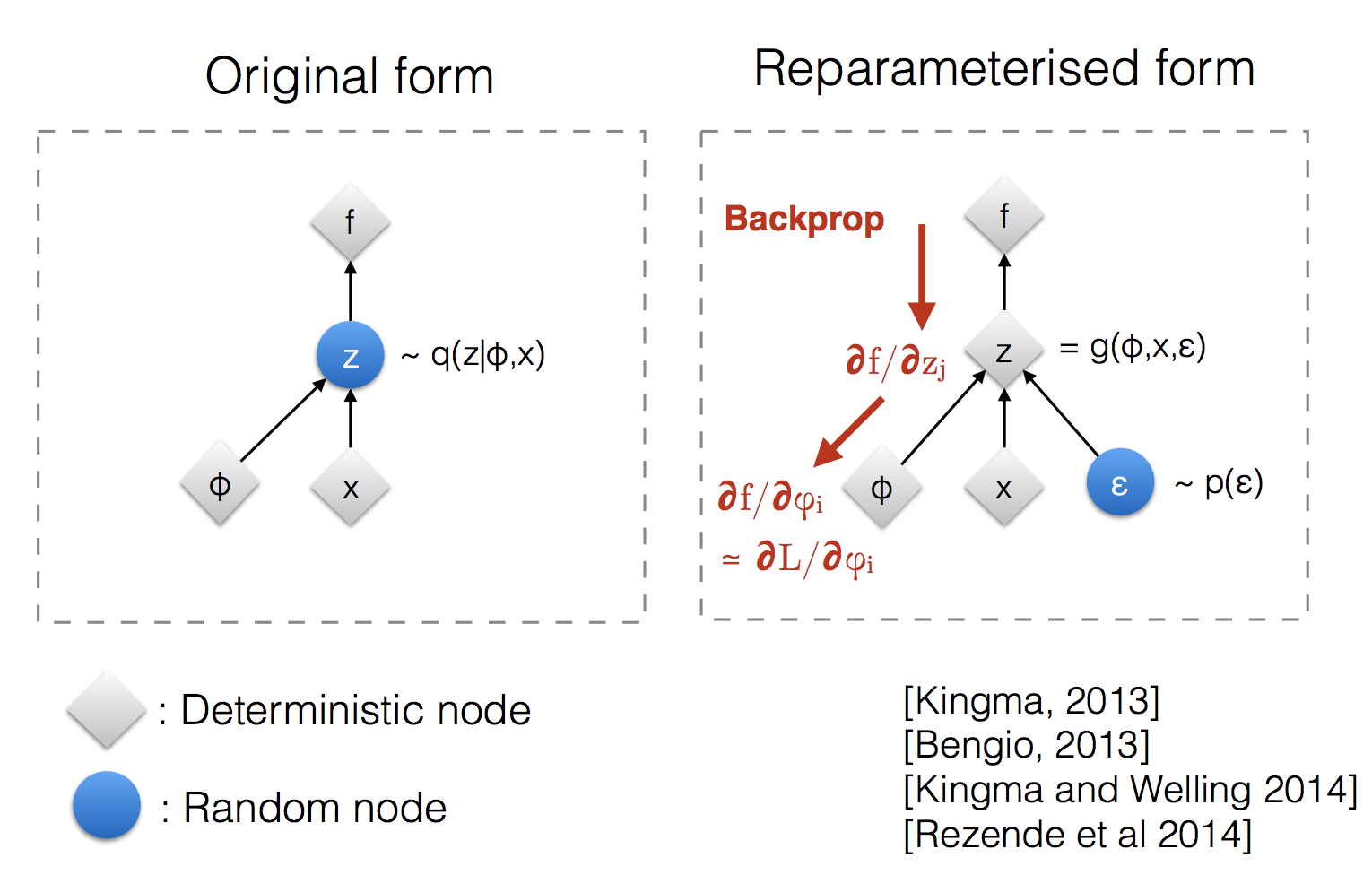 Reparameterization Trick은 Sampling 효과를 내도록 해주지만 미분불가능한 Sampling 연산이 아니므로 end-to-end로 VAE를 학습할 수 있게 해준다.
Reparameterization Trick은 Sampling 효과를 내도록 해주지만 미분불가능한 Sampling 연산이 아니므로 end-to-end로 VAE를 학습할 수 있게 해준다.
그리고 코드에서 눈에 띄는 점이 하나 더 있는데요, 바로 뉴럴넷을 forwarding 하면서 self.kld 라는 값을 계산해 낸다는 점이다.
def forward(self, x):
x = torch.flatten(x, start_dim=1)
x = F.relu(self.linear1(x))
mu = self.linear_mean(x) # mean
sigma = torch.exp(self.linear_variance(x)) # variance
z = mu + sigma * self.N.sample(mu.shape) # sampled with reparm trick
self.kld = (sigma**2 + mu**2 - torch.log(sigma) - 1/2).sum() # closed-form kl divergence solution
return z
이 부분은 원래 Objective Function 에 있는 두 항 중 우항에 해당하는 것인데,
\[\hat{\theta},\hat{\phi} = arg max_{\theta,\phi} ( \sum_{i=1}^{N} [ log p_{\theta} (x_i \vert \mu_{\phi} (x_i) + \epsilon \sigma_{\phi} (x_i) ) - D_{KL} ( q_{\phi} (z \vert x_i ) \parallel p(z) ) ] )\]이건 \(p(z)\) 라는 매우 간단한 가우시안 분포와 Encoder가 뱉은 가우시안 분포 \(q_{\phi}(z \vert x)\) 사이의 KL Divergence (KLD) 이므로,
두 가우시안 분포의 KLD 이기 때문에 closed-form solution이 이미 알려져 있어서 이를 사용한 것이다.
마지막으로 VAE 학습시에는 아까 봤던 디코더가 z를 받아서 원본을 복원하는 reconstruction loss (AE에서도 봤던 mse loss와 아예 같음) 에 kld loss를 더해주면 끝이다.
x = x.to(device)
pred = model(x)
recon_loss = loss = F.mse_loss(pred, x, reduction='sum')
kld_loss = model.encoder.kld
loss = recon_loss + args.kld_weight * kld_loss
마찬가지로 plot을 해보자면 아래와 같은 이미지를 얻을 수 있는데, (마찬가지로 latent vector의 차원은 2차원이고, 같은 encoder, decoder 구조로 25에폭 돌림)
 Fig. 2-dim Latent Space from AutoEncoder (VAE)
Fig. 2-dim Latent Space from AutoEncoder (VAE)
2차원 분포 상에 좀 더 둥글게, 즉 가우시안 분포 내에 같은 숫자들은 같이 뭉친걸 (semantic clustering) 볼 수 있다. 마찬가지로 디코더로 latent vector 들을 디코딩해보면
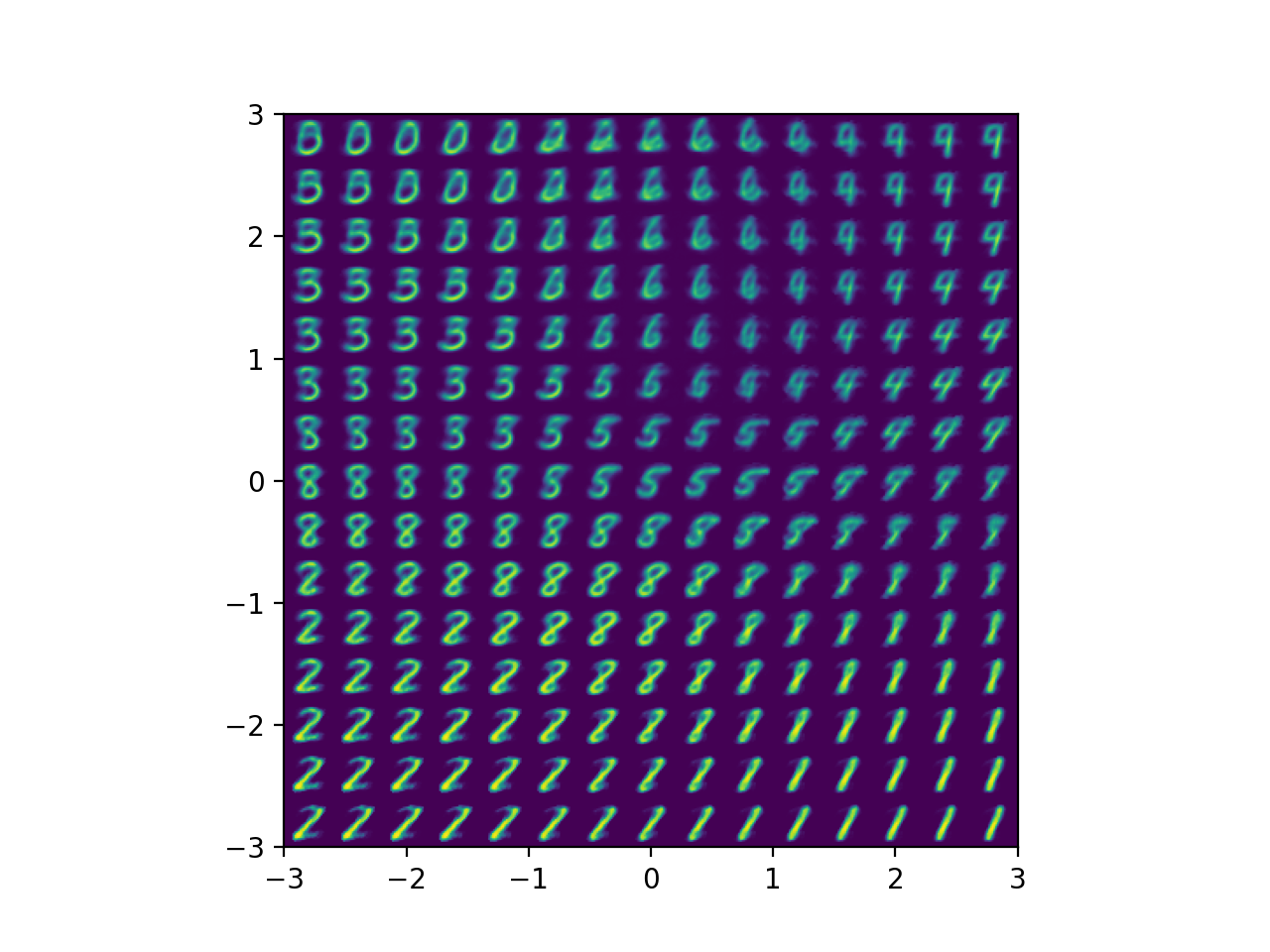 Fig. Decoded Images from 2-dim Latent Space Points (VAE)
Fig. Decoded Images from 2-dim Latent Space Points (VAE)
위와 같은 사진을 얻을 수 있다.
사실 아직 좀 만족스럽지 않을 수 있다. 왜냐면 저는 VAE 정도면 이정도는 해줘야 되는거 아니야? 라고 생각했기 때문인데,
 Fig. AE vs VAE Latent Space. Soruce from 오토인코더의 모든 것 (이활석님)
Fig. AE vs VAE Latent Space. Soruce from 오토인코더의 모든 것 (이활석님)
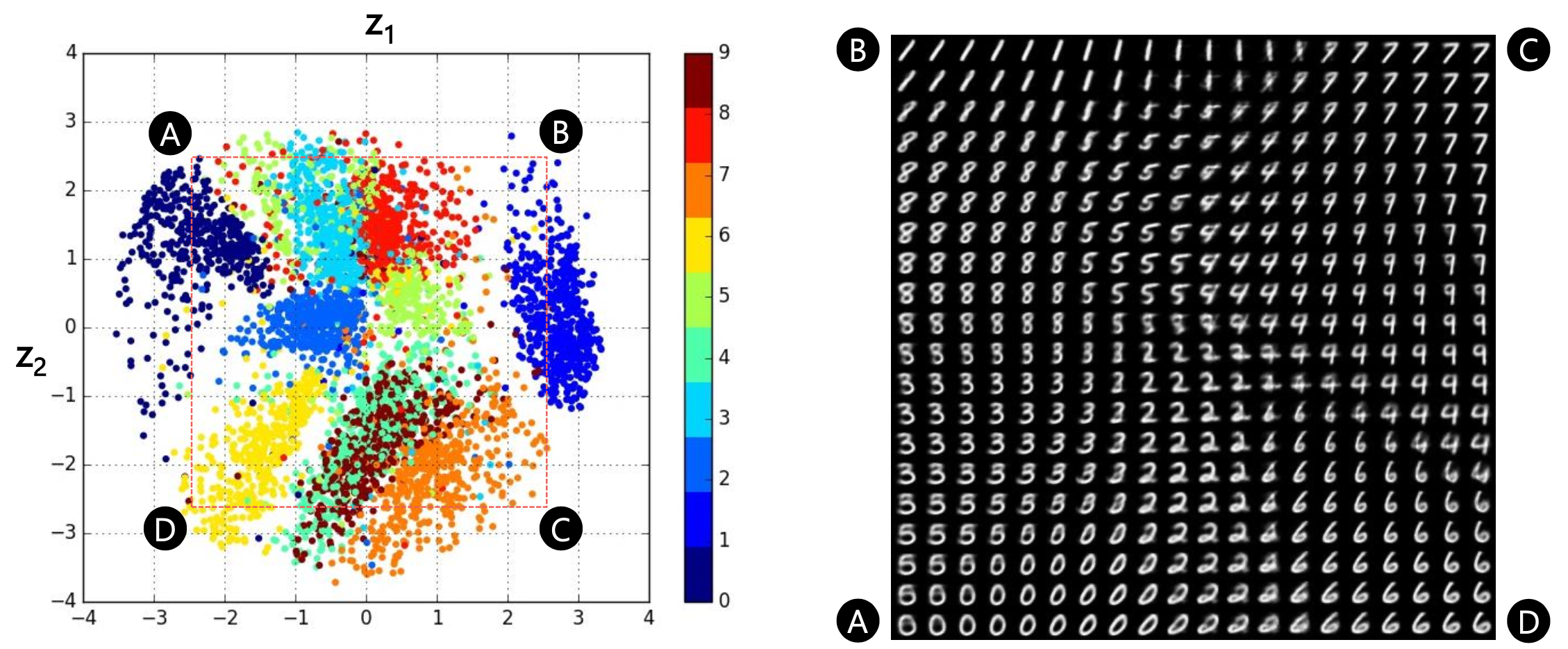 Fig. VAE Latent Space and Reconstructed Images from Latent Vectors. Soruce from 오토인코더의 모든 것 (이활석님)
Fig. VAE Latent Space and Reconstructed Images from Latent Vectors. Soruce from 오토인코더의 모든 것 (이활석님)
이 경우 Convolutional Neural Network (CNN)을 섞어주면 좋다. 알다시피 CNN은 image domain input에 대해 spatial information을 보존하면서 feature learning을 하고, 필요한 model parameter수도 확 줄여준다.
Encoder에 2D CNN layer를 4~5층 정도 쌓고,
class DeepEncoder(nn.Module):
def __init__(self, image_size, num_channel, latent_dims):
super(DeepEncoder, self).__init__()
modules = []
hidden_dims = [32, 64, 128, 256, 512] if image_size == 64 else [64, 128, 256, 512]
in_channel = num_channel
for h_dim in hidden_dims:
modules.append(
nn.Sequential(
nn.Conv2d(in_channel, out_channels=h_dim,
kernel_size= 3, stride= 2, padding = 1),
nn.BatchNorm2d(h_dim),
nn.LeakyReLU())
)
in_channel = h_dim
self.encoder = nn.Sequential(*modules)
self.linear_mean = nn.Linear(hidden_dims[-1]*4, latent_dims)
self.linear_variance = nn.Linear(hidden_dims[-1]*4, latent_dims)
self.N = torch.distributions.Normal(0, 1) # zero mean, unit variance gaussian dist
if device == 'cuda':
self.N.loc = self.N.loc.cuda() # hack to get sampling on the GPU
self.N.scale = self.N.scale.cuda()
self.kld = 0
def forward(self, x):
x = self.encoder(x)
x = torch.flatten(x, start_dim=1)
mu = self.linear_mean(x) # mean
sigma = torch.exp(self.linear_variance(x)) # variance
z = mu + sigma * self.N.sample(mu.shape) # sampled with reparm trick
self.kld = (sigma**2 + mu**2 - torch.log(sigma) - 1/2).sum() # closed-form kl divergence solution
return z
Decoder도 유사하게 쌓아주면 된다.
class DeepDecoder(nn.Module):
def __init__(self, image_size, num_channel, latent_dims):
super(DeepDecoder, self).__init__()
self.image_size = image_size
self.num_channel = num_channel
modules = []
hidden_dims = [512, 256, 128, 64, 32] if image_size == 64 else [512, 256, 128, 64]
self.decoder_input = nn.Linear(latent_dims, hidden_dims[0] * 4)
for i in range(len(hidden_dims) - 1):
modules.append(
nn.Sequential(
nn.ConvTranspose2d(hidden_dims[i],
hidden_dims[i + 1],
kernel_size=3,
stride = 2,
padding=1,
output_padding=1),
nn.BatchNorm2d(hidden_dims[i + 1]),
nn.LeakyReLU())
)
self.decoder = nn.Sequential(*modules)
# 28, 32 image size
final_conv_layer = nn.Conv2d(
hidden_dims[-1],
out_channels=num_channel,
kernel_size=5 if image_size == 28 else 3 ,
padding=0 if image_size == 28 else 1
)
self.final_layer = nn.Sequential(
nn.ConvTranspose2d(hidden_dims[-1],
hidden_dims[-1],
kernel_size=3,
stride=2,
padding=1,
output_padding=1),
nn.BatchNorm2d(hidden_dims[-1]),
nn.LeakyReLU(),
final_conv_layer
)
def forward(self, z):
out = self.decoder_input(z)
out = out.view(-1, 512, 2, 2)
out = self.decoder(out)
out = self.final_layer(out)
out = torch.sigmoid(out)
return out
그리고 use_deep_layers 라는 argument 로 이를 선택할 수 있게 한다.
class VariationalAutoencoder(nn.Module):
def __init__(self, image_size, num_channel, latent_dims, use_deep_layers):
super(VariationalAutoencoder, self).__init__()
if not use_deep_layers :
self.encoder = Encoder(image_size, num_channel, latent_dims)
self.decoder = Decoder(image_size, num_channel, latent_dims)
else:
self.encoder = DeepEncoder(image_size, num_channel, latent_dims)
self.decoder = DeepDecoder(image_size, num_channel, latent_dims)
def forward(self, x):
z = self.encoder(x)
return self.decoder(z)
그 결과 아래처럼 좀 더 오밀조밀한 공간, 즉 -3~3 정도로 더 좁은 공간에 embedding vector들이 mapping되는걸 볼 수 있고,
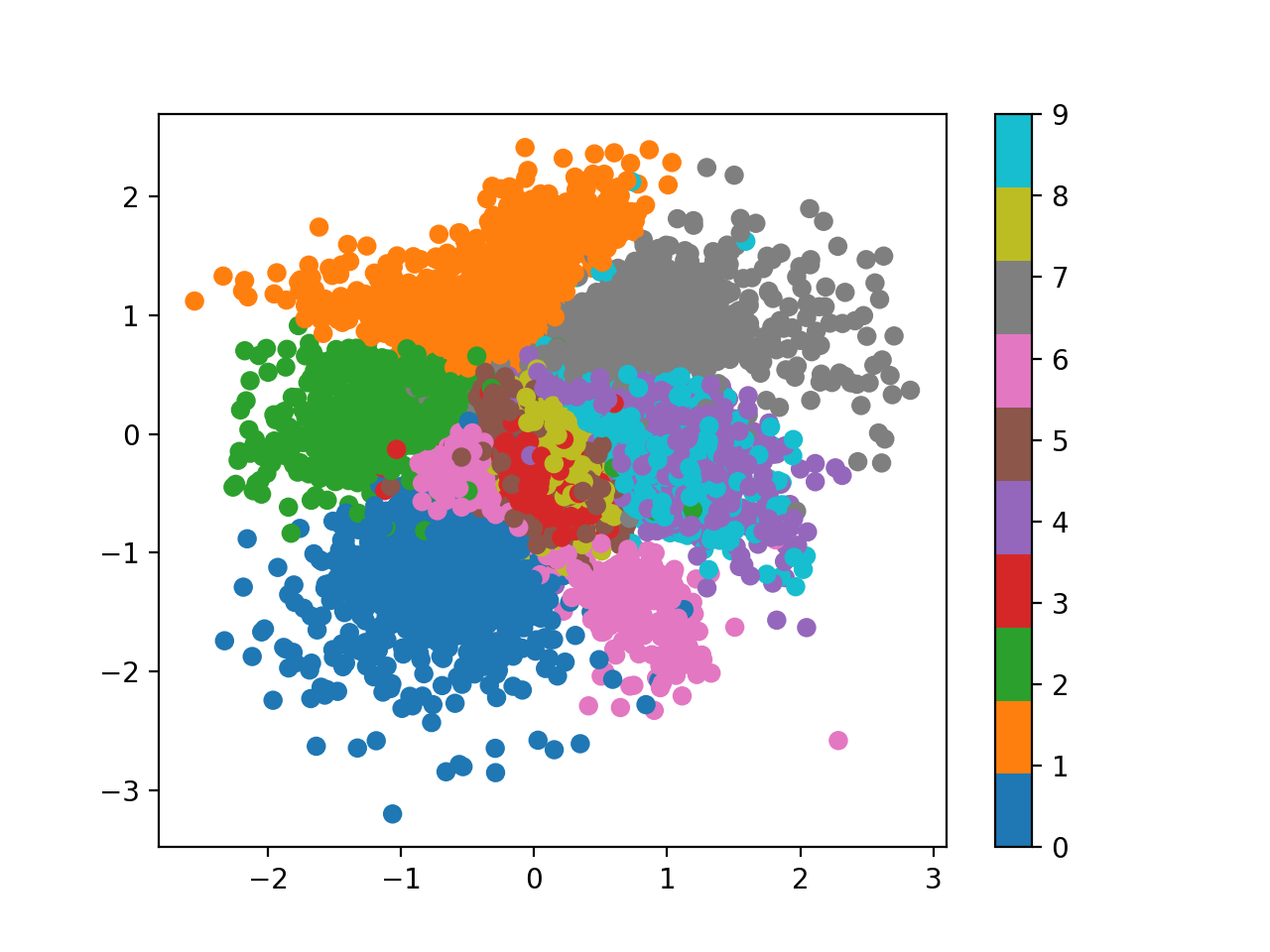 Fig.
Fig.
이 latent vector들로부터 복원한 결과도 더 깔끔한 걸 볼 수 있다.
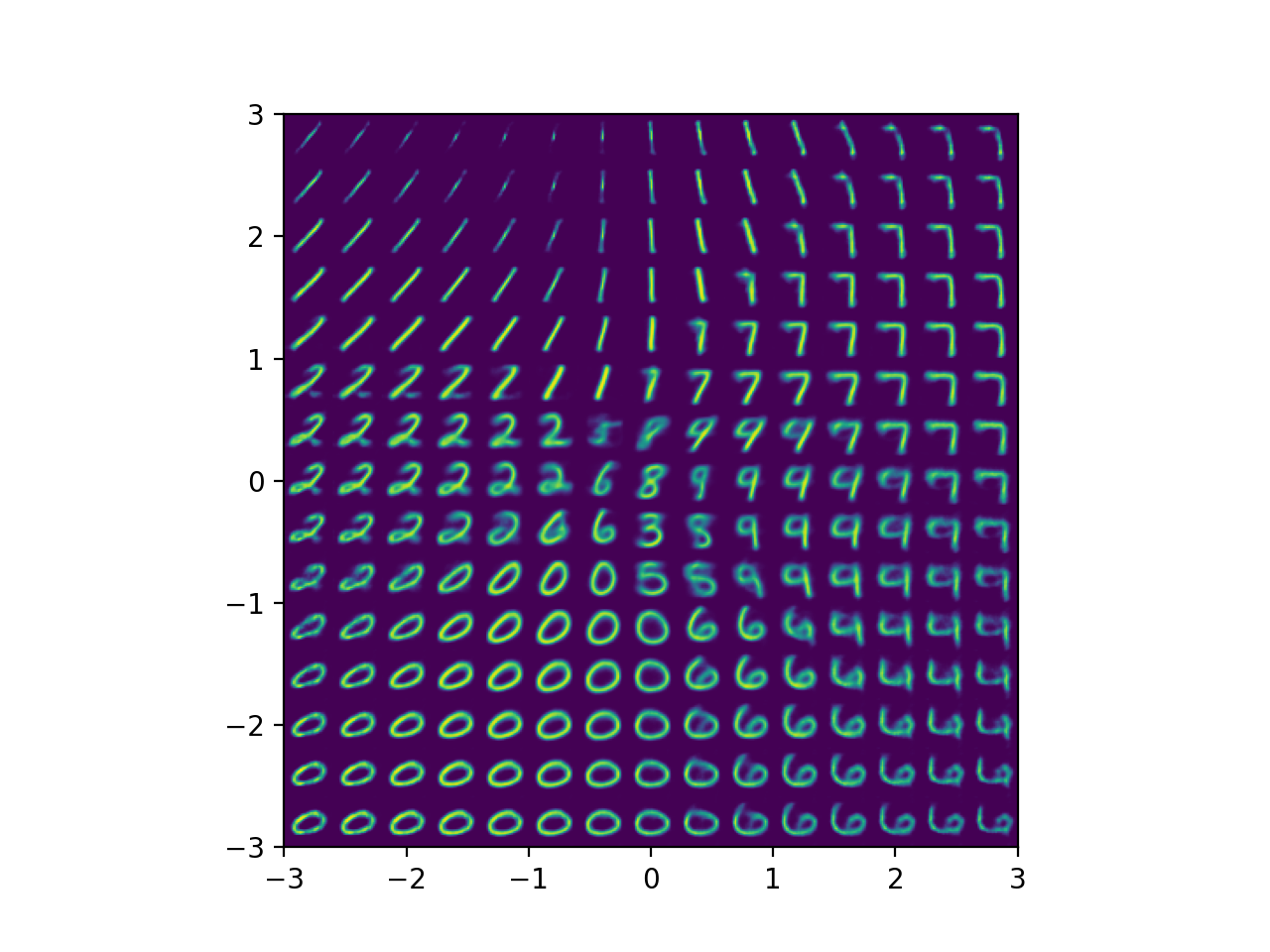 Fig.
Fig.
그리고 여기서 좀 더 나아가 원본 이미지를 Encoder -> Decoder 에 순차적으로 태워 얼마나 잘 복원하는지 확인해보면,
def plot_reconstruct_from_images(model, data_loader, save_dir_path):
og_images = None
recon_images = None
for i, (x,y) in enumerate(data_loader):
og_images = x[:10]
recon_images = model(x.to(device))[:10]
break;
plt.clf()
fig, axs = plt.subplots(2, 10, figsize=(16, 6))
for j, (og, recon) in enumerate(zip(og_images, recon_images)):
axs[0, j].imshow(og.permute(1, 2, 0).to('cpu').detach().numpy())
axs[1, j].imshow(recon.permute(1, 2, 0).to('cpu').detach().numpy())
axs[0, j].axis('off')
axs[1, j].axis('off')
plt.tight_layout()
plt.show()
file_path = os.path.join(save_dir_path,'reconstruct_from_images.png')
if os.path.exists(file_path) : os.remove(file_path)
plt.savefig(file_path)
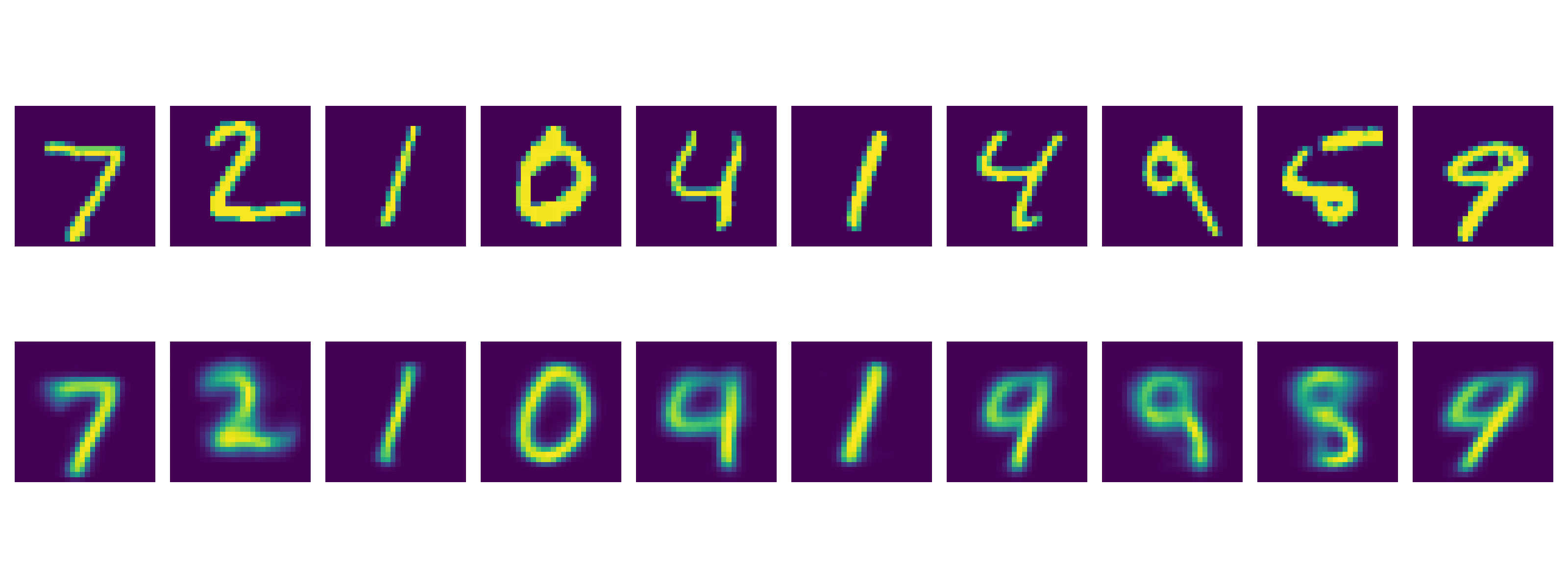 Fig.
Fig.
당연히 잘 되는걸 볼 수 있다. 다음으로 2차원의 random vector를 생성해서 Decoder에게 이미지를 복원하라고 시켜보면 이것도 잘 하는걸 볼 수 있다.
def plot_random_sample_from_prior(model, latent_dims, save_dir_path):
z = torch.randn(10, latent_dims)
samples = model.decoder(z.to(device))
plt.clf()
fig, axs = plt.subplots(1, 10, figsize=(16, 3))
for j, sample in enumerate(samples):
axs[j].imshow(sample.permute(1, 2, 0).to('cpu').detach().numpy())
axs[j].axis('off')
plt.tight_layout()
plt.show()
file_path = os.path.join(save_dir_path,'sample_from_prior.png')
if os.path.exists(file_path) : os.remove(file_path)
plt.savefig(file_path)
return samples
 Fig.
Fig.
마지막으로 Alexander Van de Kleut가 한 것처럼 두 개의 서로다른 class로 부터 latent vector를 뽑은 뒤 이 두개의 벡터를 서로 interpolation 하는 실험을 해봤다.
def interpolate(model, image_size, num_channel, save_dir_path, x1, x2, n=20):
z1 = model.encoder(x1)[0]
z2 = model.encoder(x2)[0]
z = torch.stack([z1 + (z2 - z1)*t for t in np.linspace(0, 1, n)])
interpolate_list = model.decoder(z.to(device)).to('cpu').detach()
plt.clf()
w = image_size
img = np.zeros((w, n*w, num_channel))
for i, x_hat in enumerate(interpolate_list):
x_hat = x_hat.reshape(num_channel, image_size, image_size)
recon_img = x_hat.permute(1, 2, 0).numpy()
img[:, i*w:(i+1)*w, :] = recon_img
plt.imshow(img)
plt.xticks([])
plt.yticks([])
file_path = os.path.join(save_dir_path,'interpolated_images.png')
if os.path.exists(file_path) : os.remove(file_path)
plt.savefig(file_path)
아래처럼 1과 0의 latent vector를 interpolate 하면 이상한 숫자가 decoding 되는게 아니라 embedding space상에 이 둘 사이에 mapping된 숫자들이 튀어나오는 것을 볼 수 있다.
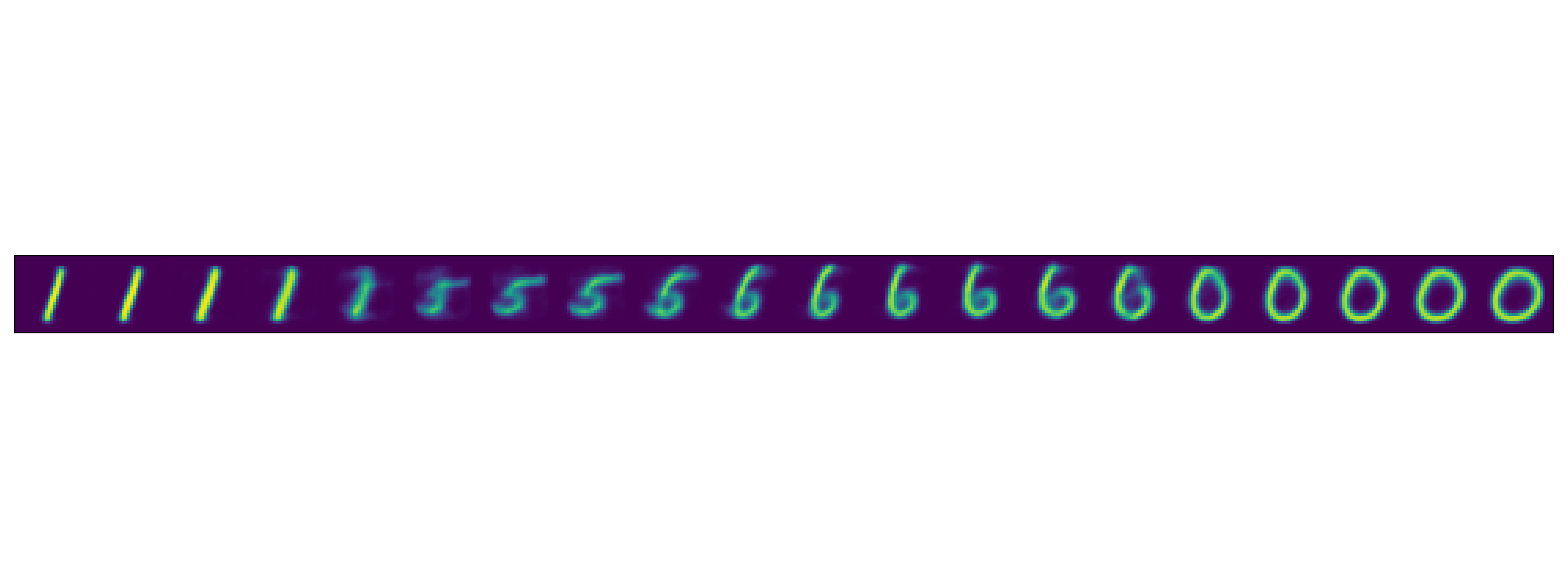 Fig.
Fig.
AE나 VAE로 학습한 인코더의 manifold가 가지는 장점은 이처럼 우리가 생각하지 못하는 데이터의 특성을 저차원에 잘 mapping시켜준다는 데 있는데,
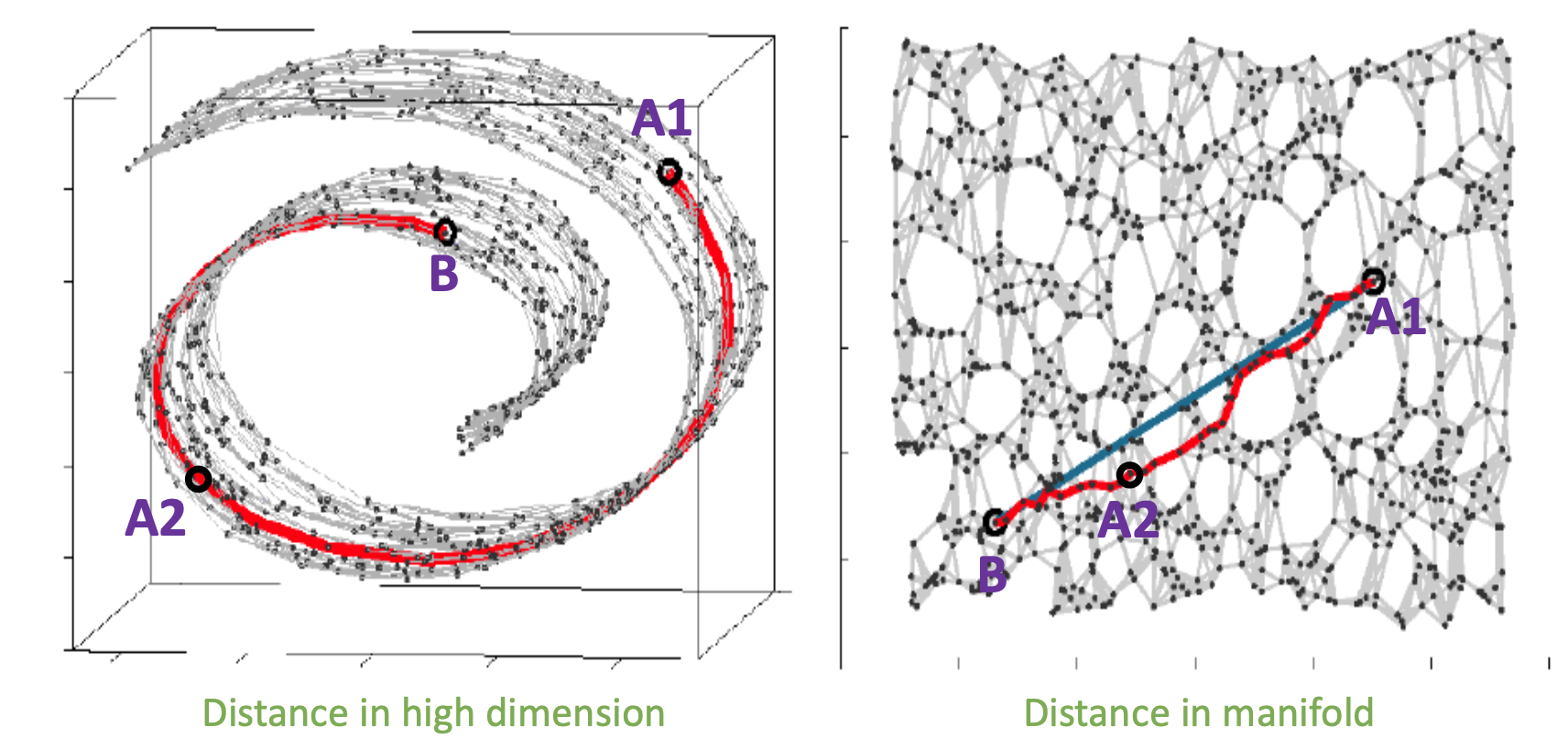 Fig.
Fig.
실제 MNIST의 원래 차원인 28*28, 즉 784차원의 고차원 공간에서는 1 과 0 (그림에서 A1과 B) 사이에 딱히 상관관계 등의 정보가 없었으나, (왼쪽 사진) VAE나 AE로 학습한 인코더는 이 관계를 잘 해석했기 때문에 그 사이에 A2 같은게 있다는걸 보여준 셈이 된다고 할 수 있겠다 (오른쪽 사진).
마지막으로 이 interpolation 하는 process를 animation으로 표현해보자.
def interpolate_gif(model, image_size, num_channel, save_dir_path, x1, x2, n=100):
z1 = model.encoder(x1)[0]
z2 = model.encoder(x2)[0]
z = torch.stack([z1 + (z2 - z1)*t for t in np.linspace(0, 1, n)])
interpolate_list = model.decoder(z.to(device)).to('cpu').detach() * 255
mode = 'F' if num_channel == 1 else 'RGB'
trans = transforms.ToPILImage(mode)
images_list = []
for x_hat in interpolate_list:
recon_img = x_hat.reshape(num_channel, image_size, image_size)
img = (trans(recon_img)).resize((256, 256))
# recon_img = x_hat.reshape(num_channel, image_size, image_size)[0]
# img2 = Image.fromarray(recon_img.numpy()).resize((256, 256))
images_list.append(img)
images_list = images_list + images_list[::-1] # loop back beginning
plt.clf()
file_path = os.path.join(save_dir_path,'interpolated_images.gif')
if os.path.exists(file_path) : os.remove(file_path)
images_list[0].save(
file_path,
save_all=True,
append_images=images_list[1:],
loop=1)
아래처럼 좀 있어보이는 gif를 얻을 수 있습니다.
 Fig.
Fig.
추가적으로 Deep CNN VAE 에 latent dimension을 128로도 키워봤는데요, 이 때는 2차원일때와 다르게 시각화 하기 힘들기 때문에 t-SNE 를 사용해서 시각화를 할 수 있는데,
def plot_latent_with_tsne(model, data_loader, save_dir_path, dim=2):
plt.clf()
latents = torch.Tensor()
labels = torch.Tensor()
for i, (x, y) in enumerate(data_loader):
# z = model.encoder(x.to(device)).to('cpu').detach().numpy()
z = model.encoder(x.to(device))
latents = torch.cat((latents,z.to('cpu')),0)
labels = torch.cat((labels,y),0)
z = latents.to('cpu').detach().numpy()
y = labels.to('cpu').detach().numpy()
tsne_vector = manifold.TSNE(
n_components=dim, learning_rate="auto", perplexity=40, init="pca", random_state=0
).fit_transform(z)
if dim == 2:
plt.scatter(tsne_vector[:, 0], tsne_vector[:, 1], c=y, cmap='tab10')
elif dim == 3:
fig = plt.figure()
ax = fig.add_subplot(projection='3d')
ax.scatter(tsne_vector[:, 0], tsne_vector[:, 1], tsne_vector[:, 2], c=y, cmap='tab10')
file_path = os.path.join(save_dir_path,'latent_space_with_tsne_{}d.png'.format(dim))
if os.path.exists(file_path) : os.remove(file_path)
plt.savefig(file_path)
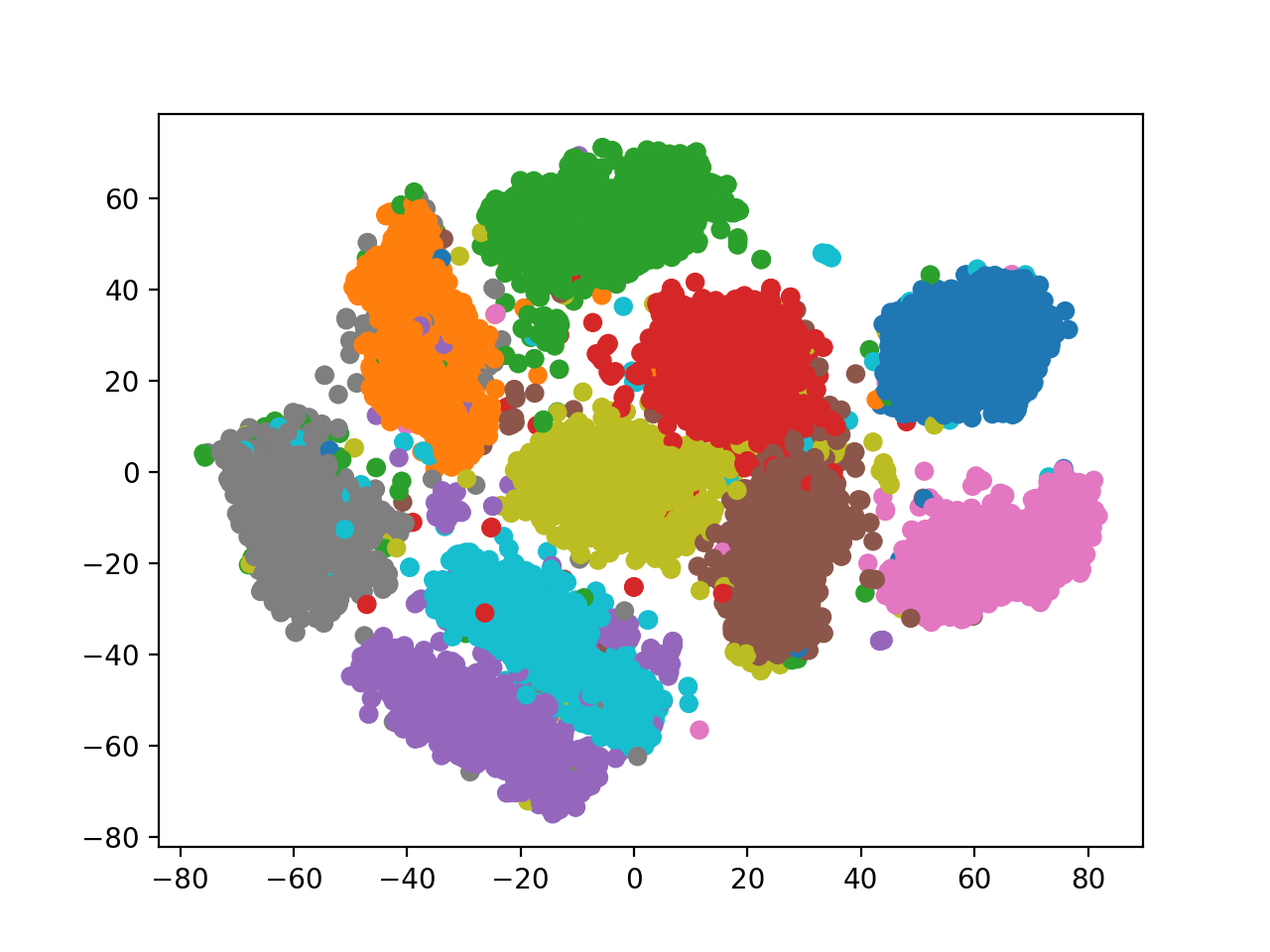 Fig. 128차원 -> 2차원 latent space 시각화
Fig. 128차원 -> 2차원 latent space 시각화
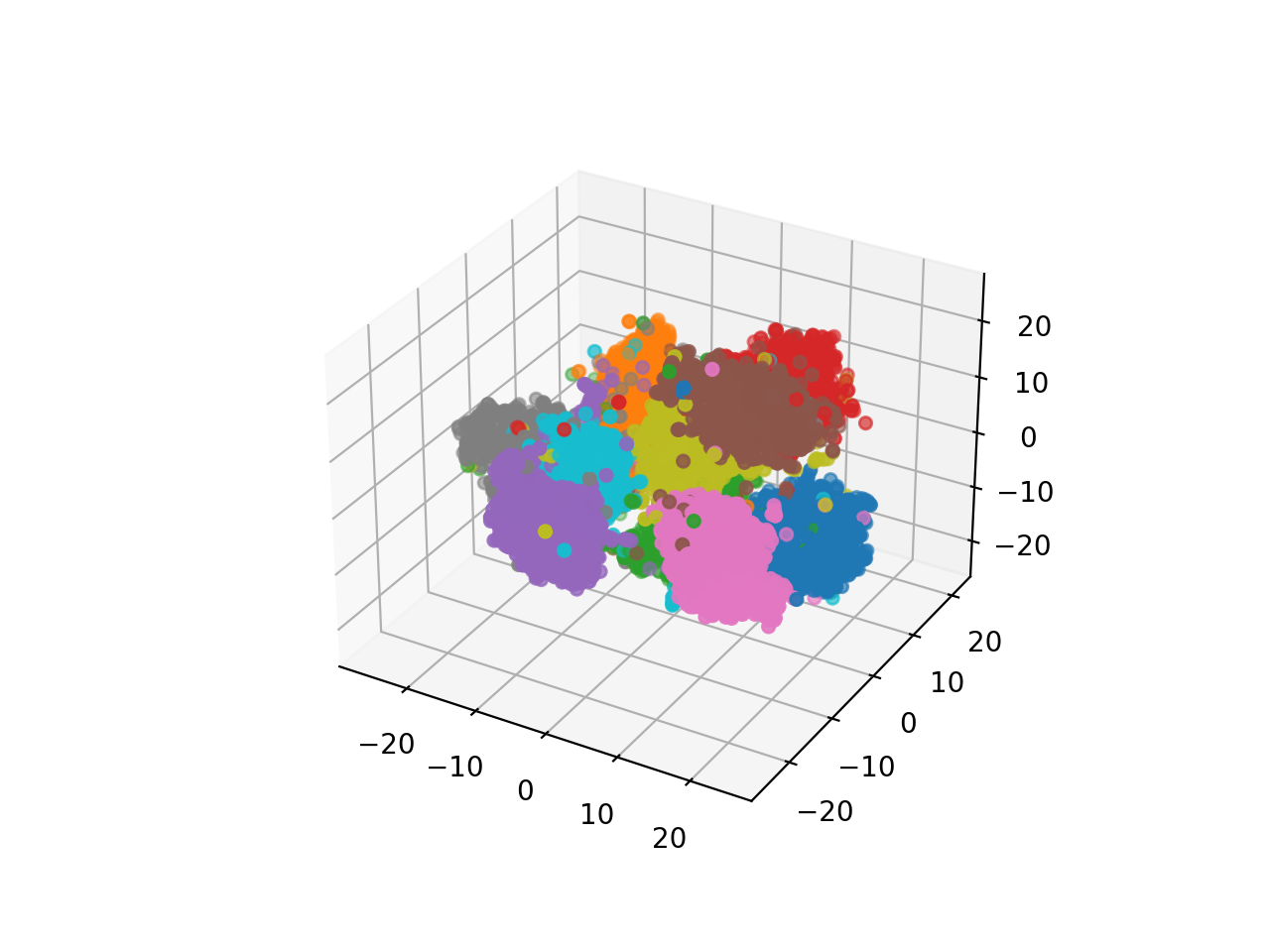 Fig. 128차원 -> 3차원 latent space 시각화
Fig. 128차원 -> 3차원 latent space 시각화
2차원일때보다 더 잘 클러스터링 된 걸 알 수 있었으나 랜덤으로 샘플링한 128차원 벡터를 디코딩 했을 때는 너무 고차원 상에 sparse하게 데이터가 mapping돼서 그런지 썩 좋지 못한 모습을 보였다.
 Fig. decoding random sampled 128 dim latent vector
Fig. decoding random sampled 128 dim latent vector
Vector Quantized Variational AutoEncoder (VQ-VAE)
- TBC (let’s check this)